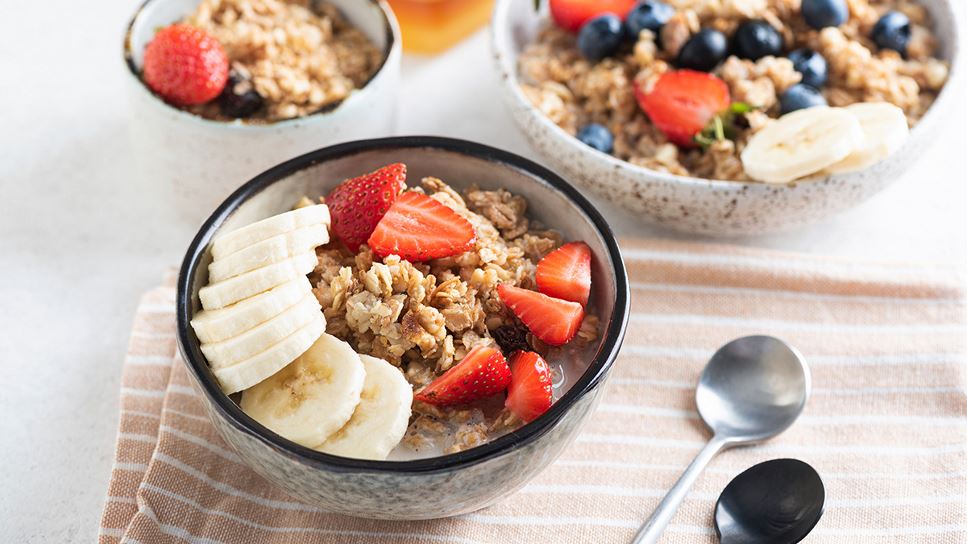It's a taboo subject but something that many people suffer from. Constipation, sometimes referred to as irregularity, is a problem with bowel movements. Symptoms may include difficulty passing stools and a feeling that not all of your stool has passed. Stools can be hard, dry, or lumpy and less frequent. If you have less than three bowel movements a week, a healthcare provider might diagnosis you with constipation.
The good news: Making smart food choices and adopting good habits can make a difference. Foods high in fiber may help keep your bowels working regularly.
Choose a Variety of Foods with Dietary Fiber
Dietary fiber may help promote health in a variety of ways. Fiber may help manage both cholesterol and blood glucose levels. Fiber may also speed up the transit of stool through the digestive system, which can help keep you regular.
The daily recommendation for dietary fiber is 14 grams for every 1,000 calories, which is about 25 grams for women and 31 grams for men per day.
Sources of dietary fiber include:
- Fruits, such as blueberries, raspberries, strawberries, pears, apples with skin on, prunes (dried or stewed) and raisins.
- Unsalted nuts and seeds, such as almonds, peanuts, pecans and walnuts, as well as pumpkin, sunflower, flax and chia seeds.
- Vegetables, such as green peas, broccoli, sweet potato, winter squash and pumpkin.
- Whole grain foods such as brown rice, whole grain bread and rolls, whole grain pastas, wheat bran and bran cereals.
In contrast, a low fiber eating pattern may contribute to constipation. Foods low in dietary fiber include refined grains, such as white bread and rolls, white rice, spaghetti and other pastas, cereals and baked goods made from white flour.
Become a Label Reader
The amount of fiber in foods is included on the food label under the “Carbohydrates” heading. Your goal is to eat 100% of the recommended daily value of fiber. When selecting products:
- Aim for foods with over 5% daily value dietary fiber per serving.
- High fiber foods contain 20% or more dietary fiber per serving.
Learn more about how to read food labels.
Increase Your Fiber Intake Slowly
Adding fiber too quickly may cause abdominal discomfort. If you have not been eating foods high in fiber, slowly increase your fiber intake.
Increase your fiber intake slowly across five days. Be careful not to increase it by more than 5 grams each day. Follow this practice until reaching your desired intake.
Pair High Fiber Foods with Fluids
Drink plenty of water or other unsweetened beverages throughout the day. Fluids help keep your stool soft, which makes them easier to pass. Including prune juice in your daily eating plan may also help keep you regular. Starting the day with a warm beverage can be helpful, too.
If you don't consume enough fluids, high fiber foods may increase your risk of constipation. How much fluid you need depends on many factors including your age, gender, activity level and the climate where you live.
Get Moving
Being active may also help to keep your bowel movements regular. Individuals who do not participate in regular physical activity may be more likely to become constipated. Short, 10 to 15 minute walks after each meal can help keep your bowels working normally.
Seek Help, If Constipation Persists
Constipation might lead to uncomfortable bloating and reduce your appetite. If your constipation is not going away, contact your healthcare provider. Ask if an over the counter medicine such as a stool softener or laxative may be helpful for you.
If your healthcare provider feels your constipation is related to your eating style, ask for a referral to a registered dietitian nutritionist (RDN). An RDN can help you identify ways to increase your fiber intake and develop a meal plan that meets your individual needs.
To find an RDN, check out the Academy’s online Find a Nutrition Expert tool.
References
Find a Nutrition Expert
Looking for credible nutrition information and recommendations? The Academy of Nutrition and Dietetics' network of credentialed food and nutrition practitioners are ready to help!

